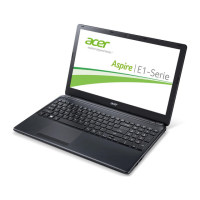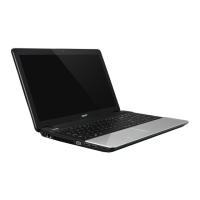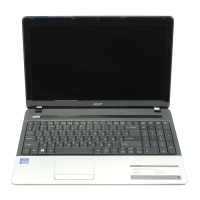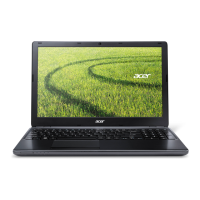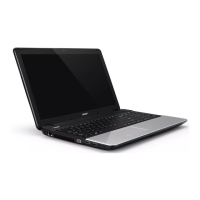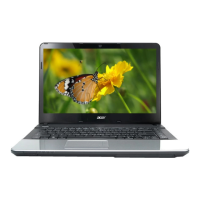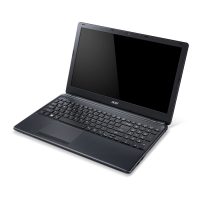Do you have a question about the Acer Aspire E1-570 and is the answer not in the manual?
Covers electrical safety, handling, ventilation, and product servicing.
Safe battery usage, RF interference, and usage restrictions.
Environmental impact, disposal, emergency calls, and comfort tips.
Introduces setup, quick guide, and user's manual.
Covers basic care, power management, AC adapter, battery, and cleaning.
Details on screen, keyboard, touchpad, ports, and base views.
Explains lock keys, hotkeys, and Windows-specific keys.
Covers basic touchpad use and multi-finger gestures.
Steps to create system and driver/application backups.
Procedures for restoring the system to previous states or factory settings.
Instructions to turn off fast startup for power saving.
Covers charging, conditioning, optimization, checking level, and installation/removal.
Steps to disconnect from accessories and move the computer short distances.
How to prepare the computer for moving or taking it home.
Tips for temperature changes, home office setup, and international travel.
Covers using security locks and setting up user/supervisor passwords.
How to connect to an Ethernet-based network using an RJ-45 port.
Connecting to the internet wirelessly and understanding WLAN components.
Explains DVD region codes and how to set them.
Covers boot sequence and setting BIOS passwords.
Addresses issues like power, display, audio, keyboard, and printer problems.
Information on requesting service and preparing for support calls.
Guidance on using Windows 8 features, personalization, and apps.
Provides tips and lists common error messages with corrective actions.
Covers FCC statement, Canadian ICES-003, and radio device notices.
Details wireless operation channels and restricted bands in France.
Lists national codes and RF safety requirements for wireless devices.
| Graphics | Intel HD Graphics 4000 |
|---|---|
| Operating System | Windows 8 |
| Processor | Intel Core i3-3217U |
| Display | 15.6-inch, 1366 x 768 pixels |
| RAM | Up to 8 GB DDR3 |
| Storage | 500 GB HDD |
| Battery | 4-cell Li-ion |
| Weight | 2.3 kg |
| Dimensions | 381.6 x 253 x 25.3 mm |
